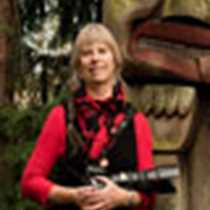Cruising the waters of the Gulf of California, Searching for marine mammals, Zodiac cruises at Isla El de Fonso
The magic of Baja California, Sur was weaving its mystery around the National Geographic Sea Lion as she began her journey north into the Gulf of California. A deep emerald green flash beamed briefly over the sea, changing rapidly into a bright yellow-orange sun, bringing light and warmth over sea, land and the National Geographic Sea Lion as she turned south to make one more circle through the Gulf waters just off of the eastern coast of Isla Carmen.
This area is known for marine mammal sightings and our morning would be dedicated to scanning the waters for just those inhabitants. Natural History staff and guests were on the bow long before sunrise and many eyes were searching the waters for any kind of movement that might signal the sighting of marine life. As one would expect, the question arose, “Why are these waters so rich in life?”
Looking west towards the Baja peninsula, the impressive Sierra de la Giganta mark the entire eastern boundary of this 1,000-mile long peninsula. The sea floor directly under the National Geographic Sea Lion is shaped in much the same manner, i.e. an enormous drop off diving deeply into the sea forming a ledge or escarpment, matched in depth to the mountains rising on the land directly to the west. During several months of the year, nutrients from the depths of the sea floor are brought up to the surface by sea currents called up welling. When these nutrients meet the light of the sun at the surface of the sea, the smallest organisms begin a chain of life that feeds the entire marine ecosystem within the Gulf’s water column for hundreds of feet. Birds, small and large fish, and many marine mammals come to these nutrient rich waters to feast on the great abundance of food.
After the National Geographic Sea Lion finished another large circle near Isla Carmen, the Expedition Leader decided to start moving north towards our later morning destination of Isla San Ildefonso. Along the way we continued our watch on the bow, and nearing this first island of the midriff area of the Gulf of California four Fin whales were spotted. Calling everyone from a lecture on marine mammals back to the bow we were all rewarded in watching Fin whales lunge feeding along the surface of the water. The Natural history staff soon discovered that in the waters around Isla San Ildefonso were many pockets or swarms of zooplankton, perfect food for Fin whales, and the second largest mammal on the planet. The four Fin whales ranged between 60 and 80 feet in length, were racing through the water, and on occasion would appear to stop mid stroke due to their mouths being held completely open as they gulped thousands of gallons of water and hundreds of thousands of tiny organisms.
Leaving these animals, the National Geographic Sea Lion made her way towards her anchorage off of the southern side of San Isla Ildefonso. Zodiacs were dropped and we all had an opportunity to explore this ancient volcanic caldera that is a rookery for many species of birds found in the Gulf of California. Once we all returned to the National Geographic Sea Lion it was our intention to cruise towards our afternoon destination on the Baja peninsula for an afternoon and evening ashore.
But, an expedition hopefully gives way for chance encounters….and the remainder of our day was filled so many chance encounters that all plans were thrown out to enjoy one visual feast after another! A group of very active Long-beaked Common dolphins were spotted leaping and frolicking in the sea. There were many babies and adults traveling rapidly and if those of us on the bow listened carefully we could hear their squeals and whistles of delight. As our ship pulled away from these very active dolphins another set of interesting blows were spotted. A group of Short-finned pilot whales and Bottlenose dolphins were spotted at play or were they teasing each other? The Pilot whales came in very close to the National Geographic Sea Lion, breaching, spy hopping, and generally watching us watch them.
Our Natural History staff dropped the hydrophone and we had another sense touched by hearing both species of dolphins as they communicated with each other. Once again plans were changed, and our evening barbeque was moved from land to the top deck of the National Geographic Sea Lion. Sunset could be enjoyed, along with our dinner and sangria outside on deck!
As darkness wrapped itself around the National Geographic Sea Lion, our Expedition Leader offered everyone a chance to go ashore for a bonfire, or remain onboard to enjoy, reflect and take in the diverse and enormous events of the day. From a green flash at sunrise, the visual feast continued throughout the day reminding each of us of our good fortune to be in this unique place we hear our Natural History staff so affectionately call “the desert by the sea.”



